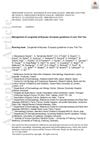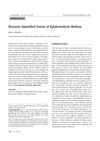Epidermolysis Bullosa in Animals: A Review
October 2014
in “
Veterinary Dermatology
”
TLDR Epidermolysis bullosa is a genetic disease causing fragile skin and blisters in both animals and humans.
The review discussed epidermolysis bullosa (EB), a hereditary disease affecting both animals and humans, characterized by skin and mucous membrane fragility leading to blisters and erosions from minor trauma. EB was caused by mutations in genes responsible for structural proteins in the skin. It was categorized into three types: epidermolysis bullosa simplex, junctional epidermolysis bullosa, and dystrophic epidermolysis bullosa. While human EB subtypes were well-defined, animal subtypes were not fully established. The review highlighted that in animals, except buffaloes, EB presented with multifocal ulcers in the oral cavity and deformities in hooves or claws, similar to nail issues in humans. The review covered molecular biology, diagnosis, classification, clinical signs, and pathology of EB in animals.



